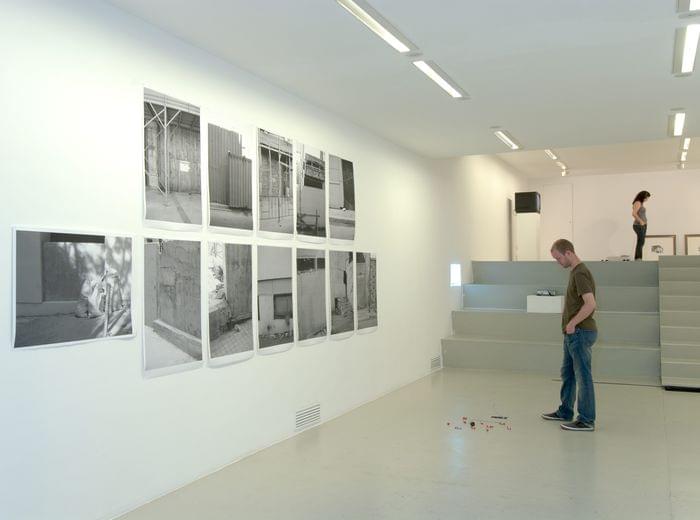
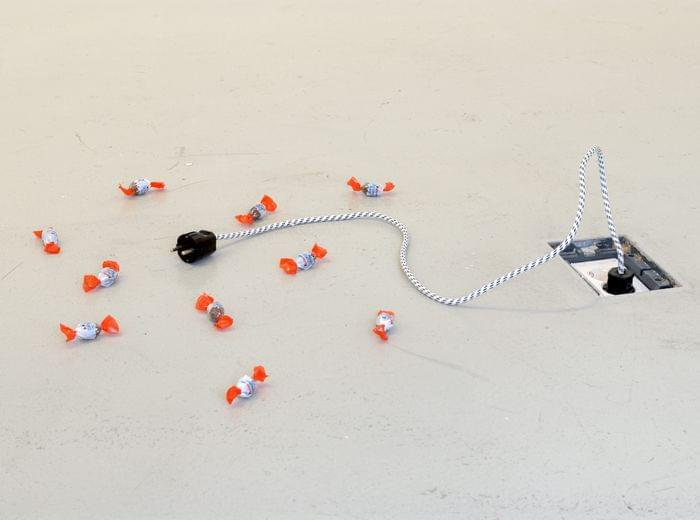
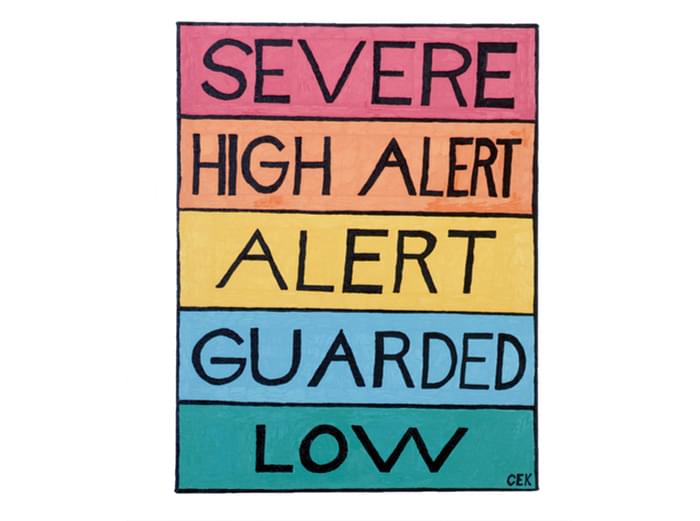
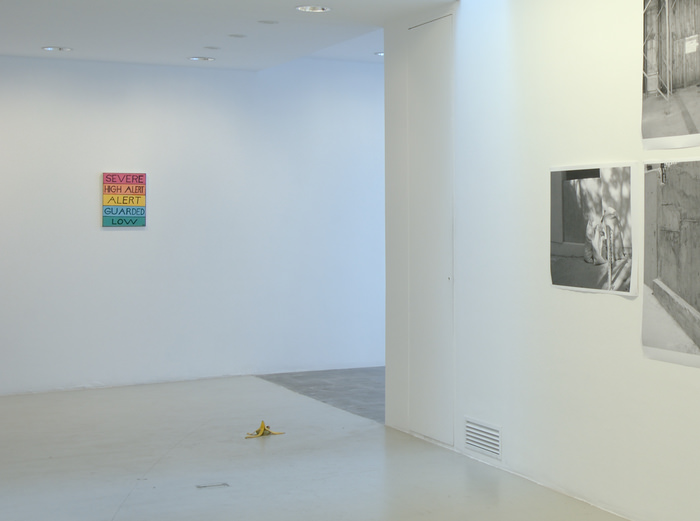

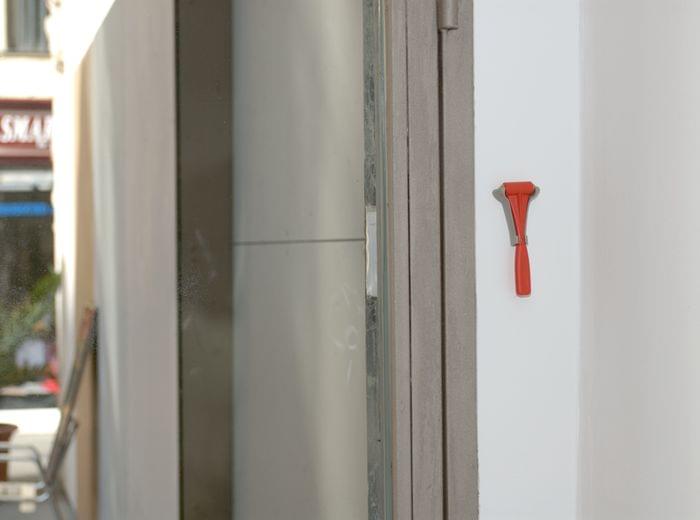
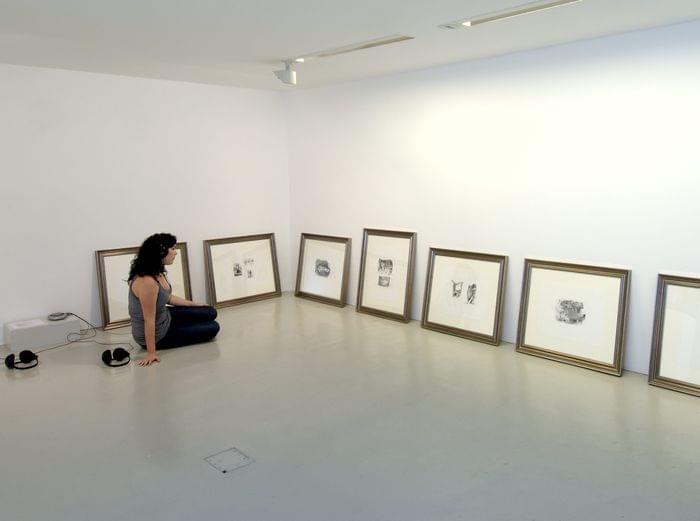
An exhibition with works by: Mariana Castillo Deball (MX/DE), Gardar Eide Einarsson (NO/US), Rainer Ganahl (AT/US), Carsten Höller (BE/SE), Christopher Knowles (US), Josephine Meckseper (DE/US), Roman Ondák (SK/DE), Wilfredo Prieto (CU) and Natascha Sadr Haghighian (DE).
The exhibition 'Extraordinary Rendition' brought together video, sculpture, audio, photography, painting and drawing by nine international artists in response to notions of risk, frictionlessness and its representation.
Following a pre-modern discourse of danger, the emergence of risk – alongside the invention of insurance – proposed a world governed by immaterial markets that were no longer regulated by order, but by fundamental uncertainty, threat and insecurity. For its contextual backdrop, this exhibition attempted to think of the present as a cultural mythology through manifestations and elaborations of this principle. One could cite the orchestration of illusory energy and finance markets, the manipulation of governance and property, or the clandestine rendition of terror suspects. (Correspondingly, the Enron scandal, corruption uncovered by operation Malaya in Marbella, or CIA stop-offs in Palma de Mallorca, for example.) Furthermore, there are the unpredictable mega-weather events or reckless insurgencies that are also symptomatic of an ever more stochastic and violent reality which similarly escapes an ordinary logic of probabilities or worth. Social sensitivity to issues of security are rapidly changing our society. Alongside this global picture, our everyday lives – especially with respect to children – are increasingly subject to a suffocating psychology of risk aversion.
Mariana Castillo Deball is concerned with the mechanisms of classification and the way facts, history and culture are written, archived, ordered and distributed. In the installation 'It rises or falls...' (2006) she revisited a popular legend around the looting and transportation of the colossal stone statue of Tláloc to the National Museum of Anthropology in Mexico City in a series of lithographs. These were presented in parallel with a selection of audio interviews with antique dealers in Amsterdam, and in Barcelona, who discussed their profession's role in the creation of value, and the uncertainties of the market. Also presented here was her parasitical edition of the sport section of The Guardian newspaper from 2003, which includes an interview with the footballer Gianni Buffon about goalkeeping, chance and play.
Gardar Eide Einarsson works include bleak paintings, iconoclastic wall texts, as well as hermetic sculptures and photographs. Setting up austere encryptions of 'scenes' and subcultures, such as skateboarding, graffiti, tattooing and punk rock, the artist's practice is a precarious questioning of what is excluded and what can be delimited as a consumable in culture. 'We'll Make The World You Live' (2005) was shown in ‘Extraordinary Rendition’. It consisted of cheaply printed photographs pinned to the wall – depicting improvised barriers, security blockades and urban obstructions that appeared on the streets of Istanbul in the wake of the November 2003 terrorist bombings. Deceptively unexceptional and obstinate, the photographs processed a theatre of violence with global infamy in relation to its municipal reality and its everyday aesthetic.
Rainer Ganahl’s 'News Paintings' such as 'FOX NEWS, 11/14/03, Black Hawks Crash in Iraq, Killing 17 Americans' (2003) attempt to freeze the relentless flow of the instantaneous yet immediately old information offered by the internet. These excessively enlarged paint-on-canvas versions of web browser windows depict sites such as Yahoo! news, Fox News or CNN as they reported breaking news stories. Amid the overload of other headlines, advertising banners, stock market alerts, corporate logos and other graphical elements on the page, the construction of history and memory is examined as an abstracted mechanism of ideological composition. As the artist has written of his role in this age of 'infotainment', "when it once might have been accurate to paint battlefields for kings of winning armies, as a quasi-voiceless consumer of news, it now appears correct for me to paint these web pages ...[where] news is news independent of the gravity of its content: dead body counts or 'best dresses' at the Oscars".
Carsten Höller's best known artworks often set up disorientating experiences, and repeatable surprises involving flying machines, hallucinogenic mushrooms, spiraling slides and mirrored carousels. Comprised of a potentially lethal electrical wire baited with chocolate treats, '220 Volt' (1992) is part of an early body of works centred around devices for causing infant mortality: a kid's garden swing that is bolted onto the edge of a thirteenth-floor roof ('Hard, Hard to be a baby',1992), the explosive 'Bicycle Bomb' (1992), or a baby bottle filled with venomous frogs, for example. Beneath the cartoonish violence of Höller's 'Killing Children' works lay a questioning of the exceptional status held by the very young in our increasingly risk-averse societies, and the particular abhorrence and moral panic reserved for the exploitation of the vulnerable.
Christopher Knowles’s paintings, opera librettos with Robert Wilson and 'typings' are hypersensitive to both the colour and physicality of language. Diagnosed as autistic as a child, Knowles continues to examine the capricious nature of hierarchies as his work has become increasingly satirical. 'Untitled (Alert Paintings)' (2004), a single part of which was included in this show, served as a reminder of how pop logic can also service political power. Depicting the US Department of Homeland Security’s Threat Advisory System, with its notorious colour-coded levels ascending from ‘Low’ (green) to ‘Severe’ (red), the artist visualized this attempt to quantify and package the threat of terrorism as an exercise in hysterical abstraction. Knowles' unique understanding of visual grammar finds its climax in this indictment of the Bush administration’s management of fear and risk under the farcical banner of a candy-coloured chart.
Josephine Meckseper’s films, photographs and installations crackle with ideological friction. Using shelves, wallpaper, broken mirrors, vitrines and shop fittings, arranged with evocations of revolution, protest and product – a chromed hammer and sickle, a stockinged mannequin leg, ostrich feathers, a shrink-wrapped toilet brush, etc.– she explores the consumption of political unrest seen through fashion and advertising. Her film 'Rest in Peace' (2004) includes Super-8 footage shot by the artist at the September 2005 rally in Washington against the war in Iraq (as well as those in New York and Berlin) intercut with historical footage of antiwar demonstrations. By accumulating and manufacturing evidence of nostalgia for the 'look' of protest, Meckseper suggested that today's demonstrative forms of political expression risk being empty reproductions of a radical chic, that are easily devoured and neutralised by the media.
The works of Roman Ondák are restrained, gently humorous and often barely distinguishable disruptions of social norms and everyday experiences. He has set up situations of displacement that might only be noticed over time, such as when he parked several old Skoda cars with Slovak license plates behind a museum in Vienna for two months ('SK Parking', 2001), or possibilities for inexplicable encounters that generated speculation, such as 'Good Feelings in Good Times' (2003), an 'artificial queue' of people that formed and dispersed without calling any attention to itself as an artistic performance. 'Untitled (Traffic)' (2001) was originally conceived for various premises in Slavonski Brod, Croatia. It consisted of the siting of emergency exit hammers, such as those installed in – or often stolen from – public buses, in locations adjacent to the gallery windows and the windows of other nearby businesses, incrementally altering our perception of the implied threat posed by these interiors.
Wilfredo Prieto often pursues an ironic strategy of what seems to be staged futility and 'much ado about nothing'. Though similarly filtered through a sense of the absurd, other pieces have required contrastingly grand maneuvers, such as a telescopic crane that attempted to lift up itself ('Crane', 2006). The apparent self-cancellation of this sculpture was also evoked in 'White Library' (2004) where shelves with 6000 blanks books tell no stories, show no images and display no knowledge, or 'Apolitical' (2001), in which flagpoles fly national flags in shades of grey, as if they've been bleached of meaning by exposure to the sun. Shown originally in the middle of a large room at the Santa Clara Convent in Havana, the work presented in this exhibition – 'Grease, Soap and Banana' (2006) – was a shorthand for a potentially frictionless moment, a slippery and 'thoughtless' artistic statement.
The practice of Natascha Sadr Haghighian has taken the form of videos, actions, animations and sound installation and is often concerned with the dilemma of visibility and authenticity. Her work questions the strategies of empowerment in accepted and authoritative representational structures. Her ongoing 'Bioswap' project, for example, seeks to deliberately confuse the notion of how biographies are used to justify who is regarded as a significant artist. The short video 'Embargo Embargo' (2003) referred to biography with a more geopolitical slant. According to the copyright specifications for Adobe software, it is illegal to download Photoshop in 'failed states' such as Cuba, Syria, Iran and Sudan, and any citizen of these countries is automatically barred from using them. 'Elsewhere 3' (2005–7) was an experience-oriented work and an intervention into the exhibition's soundscape where it seems as if someone is trying to break through the wall, an absence and a presence at the same time.
The exhibition 'Extraordinary Rendition' brought together video, sculpture, audio, photography, painting and drawing by nine international artists in response to notions of risk, frictionlessness and its representation.
Following a pre-modern discourse of danger, the emergence of risk – alongside the invention of insurance – proposed a world governed by immaterial markets that were no longer regulated by order, but by fundamental uncertainty, threat and insecurity. For its contextual backdrop, this exhibition attempted to think of the present as a cultural mythology through manifestations and elaborations of this principle. One could cite the orchestration of illusory energy and finance markets, the manipulation of governance and property, or the clandestine rendition of terror suspects. (Correspondingly, the Enron scandal, corruption uncovered by operation Malaya in Marbella, or CIA stop-offs in Palma de Mallorca, for example.) Furthermore, there are the unpredictable mega-weather events or reckless insurgencies that are also symptomatic of an ever more stochastic and violent reality which similarly escapes an ordinary logic of probabilities or worth. Social sensitivity to issues of security are rapidly changing our society. Alongside this global picture, our everyday lives – especially with respect to children – are increasingly subject to a suffocating psychology of risk aversion.
Mariana Castillo Deball is concerned with the mechanisms of classification and the way facts, history and culture are written, archived, ordered and distributed. In the installation 'It rises or falls...' (2006) she revisited a popular legend around the looting and transportation of the colossal stone statue of Tláloc to the National Museum of Anthropology in Mexico City in a series of lithographs. These were presented in parallel with a selection of audio interviews with antique dealers in Amsterdam, and in Barcelona, who discussed their profession's role in the creation of value, and the uncertainties of the market. Also presented here was her parasitical edition of the sport section of The Guardian newspaper from 2003, which includes an interview with the footballer Gianni Buffon about goalkeeping, chance and play.
Gardar Eide Einarsson works include bleak paintings, iconoclastic wall texts, as well as hermetic sculptures and photographs. Setting up austere encryptions of 'scenes' and subcultures, such as skateboarding, graffiti, tattooing and punk rock, the artist's practice is a precarious questioning of what is excluded and what can be delimited as a consumable in culture. 'We'll Make The World You Live' (2005) was shown in ‘Extraordinary Rendition’. It consisted of cheaply printed photographs pinned to the wall – depicting improvised barriers, security blockades and urban obstructions that appeared on the streets of Istanbul in the wake of the November 2003 terrorist bombings. Deceptively unexceptional and obstinate, the photographs processed a theatre of violence with global infamy in relation to its municipal reality and its everyday aesthetic.
Rainer Ganahl’s 'News Paintings' such as 'FOX NEWS, 11/14/03, Black Hawks Crash in Iraq, Killing 17 Americans' (2003) attempt to freeze the relentless flow of the instantaneous yet immediately old information offered by the internet. These excessively enlarged paint-on-canvas versions of web browser windows depict sites such as Yahoo! news, Fox News or CNN as they reported breaking news stories. Amid the overload of other headlines, advertising banners, stock market alerts, corporate logos and other graphical elements on the page, the construction of history and memory is examined as an abstracted mechanism of ideological composition. As the artist has written of his role in this age of 'infotainment', "when it once might have been accurate to paint battlefields for kings of winning armies, as a quasi-voiceless consumer of news, it now appears correct for me to paint these web pages ...[where] news is news independent of the gravity of its content: dead body counts or 'best dresses' at the Oscars".
Carsten Höller's best known artworks often set up disorientating experiences, and repeatable surprises involving flying machines, hallucinogenic mushrooms, spiraling slides and mirrored carousels. Comprised of a potentially lethal electrical wire baited with chocolate treats, '220 Volt' (1992) is part of an early body of works centred around devices for causing infant mortality: a kid's garden swing that is bolted onto the edge of a thirteenth-floor roof ('Hard, Hard to be a baby',1992), the explosive 'Bicycle Bomb' (1992), or a baby bottle filled with venomous frogs, for example. Beneath the cartoonish violence of Höller's 'Killing Children' works lay a questioning of the exceptional status held by the very young in our increasingly risk-averse societies, and the particular abhorrence and moral panic reserved for the exploitation of the vulnerable.
Christopher Knowles’s paintings, opera librettos with Robert Wilson and 'typings' are hypersensitive to both the colour and physicality of language. Diagnosed as autistic as a child, Knowles continues to examine the capricious nature of hierarchies as his work has become increasingly satirical. 'Untitled (Alert Paintings)' (2004), a single part of which was included in this show, served as a reminder of how pop logic can also service political power. Depicting the US Department of Homeland Security’s Threat Advisory System, with its notorious colour-coded levels ascending from ‘Low’ (green) to ‘Severe’ (red), the artist visualized this attempt to quantify and package the threat of terrorism as an exercise in hysterical abstraction. Knowles' unique understanding of visual grammar finds its climax in this indictment of the Bush administration’s management of fear and risk under the farcical banner of a candy-coloured chart.
Josephine Meckseper’s films, photographs and installations crackle with ideological friction. Using shelves, wallpaper, broken mirrors, vitrines and shop fittings, arranged with evocations of revolution, protest and product – a chromed hammer and sickle, a stockinged mannequin leg, ostrich feathers, a shrink-wrapped toilet brush, etc.– she explores the consumption of political unrest seen through fashion and advertising. Her film 'Rest in Peace' (2004) includes Super-8 footage shot by the artist at the September 2005 rally in Washington against the war in Iraq (as well as those in New York and Berlin) intercut with historical footage of antiwar demonstrations. By accumulating and manufacturing evidence of nostalgia for the 'look' of protest, Meckseper suggested that today's demonstrative forms of political expression risk being empty reproductions of a radical chic, that are easily devoured and neutralised by the media.
The works of Roman Ondák are restrained, gently humorous and often barely distinguishable disruptions of social norms and everyday experiences. He has set up situations of displacement that might only be noticed over time, such as when he parked several old Skoda cars with Slovak license plates behind a museum in Vienna for two months ('SK Parking', 2001), or possibilities for inexplicable encounters that generated speculation, such as 'Good Feelings in Good Times' (2003), an 'artificial queue' of people that formed and dispersed without calling any attention to itself as an artistic performance. 'Untitled (Traffic)' (2001) was originally conceived for various premises in Slavonski Brod, Croatia. It consisted of the siting of emergency exit hammers, such as those installed in – or often stolen from – public buses, in locations adjacent to the gallery windows and the windows of other nearby businesses, incrementally altering our perception of the implied threat posed by these interiors.
Wilfredo Prieto often pursues an ironic strategy of what seems to be staged futility and 'much ado about nothing'. Though similarly filtered through a sense of the absurd, other pieces have required contrastingly grand maneuvers, such as a telescopic crane that attempted to lift up itself ('Crane', 2006). The apparent self-cancellation of this sculpture was also evoked in 'White Library' (2004) where shelves with 6000 blanks books tell no stories, show no images and display no knowledge, or 'Apolitical' (2001), in which flagpoles fly national flags in shades of grey, as if they've been bleached of meaning by exposure to the sun. Shown originally in the middle of a large room at the Santa Clara Convent in Havana, the work presented in this exhibition – 'Grease, Soap and Banana' (2006) – was a shorthand for a potentially frictionless moment, a slippery and 'thoughtless' artistic statement.
The practice of Natascha Sadr Haghighian has taken the form of videos, actions, animations and sound installation and is often concerned with the dilemma of visibility and authenticity. Her work questions the strategies of empowerment in accepted and authoritative representational structures. Her ongoing 'Bioswap' project, for example, seeks to deliberately confuse the notion of how biographies are used to justify who is regarded as a significant artist. The short video 'Embargo Embargo' (2003) referred to biography with a more geopolitical slant. According to the copyright specifications for Adobe software, it is illegal to download Photoshop in 'failed states' such as Cuba, Syria, Iran and Sudan, and any citizen of these countries is automatically barred from using them. 'Elsewhere 3' (2005–7) was an experience-oriented work and an intervention into the exhibition's soundscape where it seems as if someone is trying to break through the wall, an absence and a presence at the same time.
NoguerasBlanchard
c/ Xuclà, 7
08001 Barcelona
Spain
www.noguerasblanchard.com
We thank the collaboration of all the participating artists; Galeria Abbas (formerly Kunstbuero), Vienna; Esther Schipper, Berlin; Galerie Martin Janda, Vienna; Gavin Brown Enterprise, New York; Galerie Reinhard Hauff, Stuttgart; Johann König, Berin; Team (Gallery, inc.), New York.
c/ Xuclà, 7
08001 Barcelona
Spain
www.noguerasblanchard.com
We thank the collaboration of all the participating artists; Galeria Abbas (formerly Kunstbuero), Vienna; Esther Schipper, Berlin; Galerie Martin Janda, Vienna; Gavin Brown Enterprise, New York; Galerie Reinhard Hauff, Stuttgart; Johann König, Berin; Team (Gallery, inc.), New York.
Archives
- Essay – Max Andrews essay on Christopher Knowles 21 July 2017
- Reseña exposición – ‘Vivir para contarlo/Live to tell the tale’
Bea Espejo, ArteContexto n. 14, Verano/Summer 2007, pp. 126-127 (EN y ES) (PDF) - Reseña exposición – ‘En alerta siempre’
Noèlia Hernández, Culturas, La Vanguardia, 9 Mayo 2007, p.22 (PDF) - Reseña exposición – ‘De galerías por Barcelona’,
Roberta Bosco, El Viajero, El País, 5 Mayo 2007, p.5 (PDF) - Reseña exposición – ‘Arte, juego y riesgo’
Arnau Puig, ABCD, 21 Abril 2007, p.46 (PDF) - Reseña exposición – ’If I can’t dance, I don’t want to be part of your revolution’
Montse Badia, www.A-Desk.org, Abril 2007, Num.14 - Agenda – 'Calle 20'
Marzo 2007, p.85 (PDF) - Exhibition Layout
Gallery Plan of 'Extraordinary Rendition' (PDF) - Exhibition Newspaper
English/Spanish (PDF) - Press Release
English/Spanish (PDF)